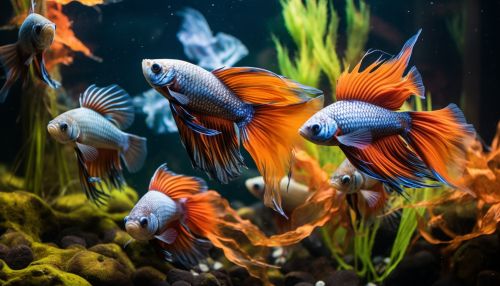The Evolution of Cooperative Behavior in Fish
Introduction
Cooperative behavior in fish is a fascinating area of study within the field of ethology, the scientific and objective study of animal behavior. This article delves into the evolution of such behavior, examining the various factors that have led to its development and the different forms it takes in aquatic environments.
Cooperation in Fish


Cooperation among fish is a complex phenomenon that involves a range of behaviors, from simple schooling and shoaling to more intricate forms of cooperation such as cooperative hunting and breeding. These behaviors have evolved over time due to various evolutionary pressures and benefits.
Schooling and Shoaling
One of the most common forms of cooperative behavior in fish is schooling and shoaling. This is where a group of fish swim together in a coordinated manner. This behavior has numerous benefits, including increased foraging efficiency, better protection from predators, and enhanced mating opportunities.
Cooperative Hunting
Cooperative hunting is another form of cooperative behavior observed in some species of fish. This involves two or more fish working together to capture prey. This behavior has been observed in species such as the coral grouper and the giant trevally, which have been known to hunt cooperatively with other species.
Cooperative Breeding
Cooperative breeding is a form of cooperative behavior where individuals contribute to the rearing of offspring that are not their own. This behavior is observed in a few species of fish, such as the Neolamprologus pulcher, a species of cichlid fish from Lake Tanganyika in Africa.
Evolution of Cooperative Behavior
The evolution of cooperative behavior in fish is a complex process that has been influenced by a variety of factors, including environmental conditions, predation pressure, and the availability of resources.
Environmental Conditions
Environmental conditions play a significant role in the evolution of cooperative behavior in fish. For instance, in environments where resources are scarce, cooperation can increase the efficiency of foraging and resource utilization, thereby increasing the chances of survival.
Predation Pressure
Predation pressure is another important factor that has influenced the evolution of cooperative behavior in fish. Schooling and shoaling behavior, for instance, can provide protection from predators, as a large group of fish is more difficult for a predator to target than a single individual.
Availability of Resources
The availability of resources can also influence the evolution of cooperative behavior in fish. In environments where resources are abundant, there may be less need for cooperation. However, in environments where resources are scarce, cooperation can be beneficial.
Conclusion
The evolution of cooperative behavior in fish is a complex and fascinating process. It is influenced by a variety of factors and takes many forms, from simple schooling and shoaling to more complex behaviors such as cooperative hunting and breeding. Understanding this behavior can provide valuable insights into the ecology and evolution of fish, and can also have practical implications for fisheries management and conservation efforts.
